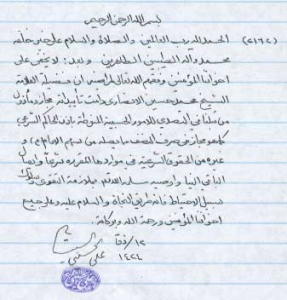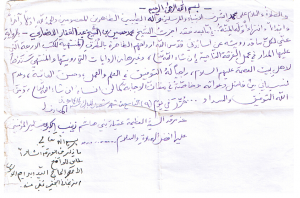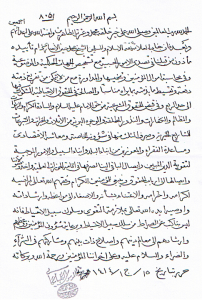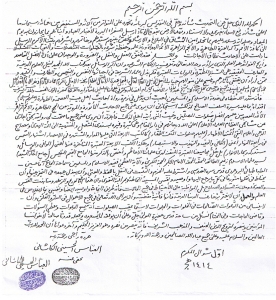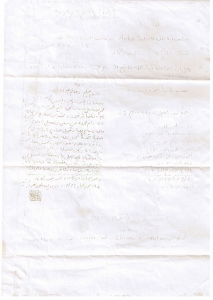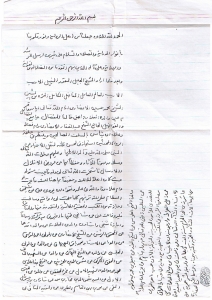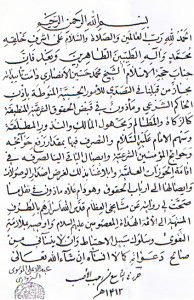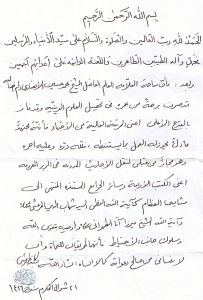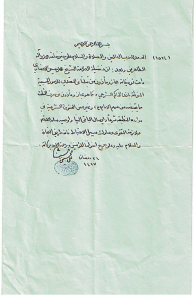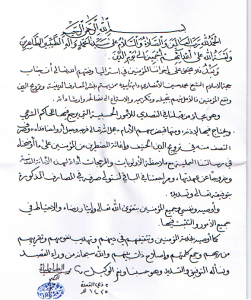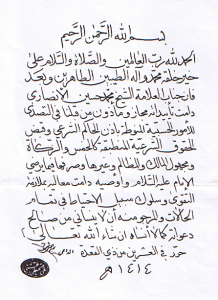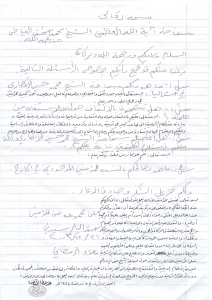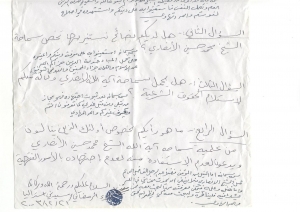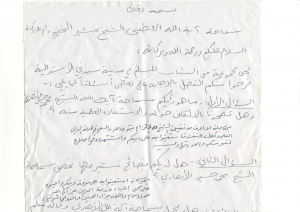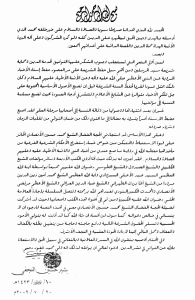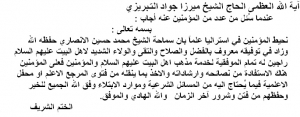Brief Biography of His Eminence
Ayatollah Sheikh Mohammad Hussein Al-Ansari
Synopsis
Born in Iraq in 1952, Ayatollah Sheikh Mohammad Hussein Al-Ansari reached the highest scholarly level in Islam ‘Ijtihad’ in 1996. Prior to his religious studies, he completed a bachelor degree in Civil Engineering from Baghdad University. Ayatollah Al-Ansari is a leading scholar, renown in the Islamic Seminaries in Najaf, Qom and Mashhad and the world over as an approachable, humble scholar who is open to all and leads by an exceptional ethical standard. He has made a significant contribution to knowledge and understanding of various areas of Jurisprudence, Beliefs and Islamic thought through his lectures, research, books and articles. Uniquely, he has travelled and lived in a plethora of continents and is presently the spiritual guide of Shia Muslims in Australia.
Early Life and Education
Ayatollah Al-Ansari was born in the city of Amara, Iraq on September 22nd 1952, to a prominent scholarly family with a long and noble history in Islam who are direct descendants of one of the closest companions to the beloved Prophet (s) Jabir ben Abdullah Al-Ansari. Ayatollah Al-Ansari’s father, Grand Scholar Sheikh Abdul Ghaffar Al-Ansari was the foremost Shia scholar of South Iraq and widely known for his knowledge, ethics, poetry and generosity. As a teenager, Ayatollah Al-Ansari studied ethics and religion under his father as well as other local scholars in parallel to his formal education. Following the completion of his secondary schooling, he pursued tertiary education at the University of Baghdad where he received a Bachelor degree in Civil Engineering. His decision to take this path was rooted in the believe that completing an academic degree within a University would further develop his critical and creative mind before indulging in deep theological studies. While at University he continued Islamic studies through reading, discussions and debates. Upon graduating from Civil Engineering in 1975, he put his knowledge into practice for one year before deciding to further his Islamic studies in the renown religious seminary of Holy Najaf.
Migration to Holy Najaf
Ayatollah Al-Ansari continued his long dream of a scholarly life, leaving behind a well-paid and comfortable life in order for him to dedicate his existence for others. This was during a period when living in the Religious Seminary of Holy Najaf was met with poverty, hardship and the constant threat and persecution by authorities at the time. It was well known that this was the price one had to pay to pursue knowledge in this most famous seminary in the Shia world. A scholarly pursuit that was nourished by spiritual and ethical conditioning from those who dedicated entirely to this field as Ahlayl Bayt (s) intended it and practiced it in their lives.
His unwavering commitment and dedication to this honoured pursuit saw him quickly excel the introductory levels of the Hawza. It was also aided by his previous studies and focus on the Arabic language and literature. Ayatollah Al-Ansari was soon invited to commence teaching in the Hawza of Najaf while continuing to pursue further studies under a plethora of learned scholars at the time. It was during this period that he married the daughter of the renowned Mirza Mohammad Al-Khalili in 1979.
Early into his scholarship, Ayatollah Al-Ansari earned a reputation as a critical academic with a sharp eye for detail. This, coupled with his academic dedication led him to become a close aide to several prominent scholars of that period not withstanding the most notable of all His Eminence Grand Ayatollah Sayed Al-Khoei, who was a teacher, mentor and role-model for the young Sheikh Al-Ansari.
Another of his notable teachers at the time was Grand Ayatollah Mohammad Baqir al-Sadr whose open opposition to the Baathist oppression led to his arrest and execution in 1980. Afer this atrocity and carrying the responsibility of delivering the news to the world he was forced to flee Iraq. He subsequently travelled to India shortly after the barbaric killing to make the international announcement. Despite having an even higher price on his head after making this announcement, Sheikh Al-Ansari’s eagerness to resume studies and teaching saw him go back into Najaf after only 3 months in India.
He returned to Holy Najaf and continued studying and teaching despite increased pressure and threats from the Baathist Regime. He was subjected to be detained and tortured on numerous occasions and sentenced to death (later overturned) in the 1980s alongside hundreds of innocent colleagues of the Hawza. This only fueled his determination to excel academically. The cycle of being detained and tortured then released continued until the popular uprising of 1991.
During the uprising, Grand Ayatollah Sayed Al-Khoei had to act to bring law and order into the liberated provinces of Iraq. As a result he appointed two committees, one with a scholarly focus the other a military one. Out of all the scholars in the Hawza at the time, Sheikh Al-Ansari was entrusted with the imperative role to act as the trusted connector between these two committees. Grand Ayatollah Sayed Al-Khoei also entrusted Ayatollah Al-Ansari with the responsibility for Public Health.
The fall of Najaf and subsequent genocide at the hands of the Baathist regime forced Sheikh Al-Ansari out of the Holy city of Najaf once more. At this time he decided to settle in the Holy city of Qom, Iran to continue his scholarly path.
Some of his main lecturers in Holy Najaf were their eminences:
- Grand Ayatollah Sayed Abul Qassim Khoei
- Grand Ayatollah Sheikh Basheer Hussein Al-Najafy
- Grand Ayatollah Sheikh Ishaq Al-Fayyad
- Grand Ayatollah Shaheed Sayed Mohammad Baqir Al-Sadr
- Grand Ayatollah Shaheed Sheikh Ali Gharawi
- Grand Ayatollah Shaheed Sayed Abdul Sahib Al-Hakeem
Some of his mentors in spirituality and ethics in Holy Najaf were their eminences:
- Grand Ayatollah Sayed Abdul Aala Sabzawari
- Grand Ayatollah Sheikh Mohammad Amin Zainul Deen
Migration to Holy Qom
In the Holy city of Qom he continued teaching and attending the lectures of his first cousin, Grand Ayatollah Sheikh Ahmed Sebt al-Sheikh Al-Ansari until the late Marjea died about 1996 where he shifted his focus to making a contribution through lectures in high levels of Fiqh (jurisprudence), Usool (principles of reasoning), Aqaed (beliefs), Tafseer (commentaries on the Quan) and Akhlaq (ethics). That same year saw Ayatollah Al-Ansari attaining the level of Ijtehad (highest scholarly level in Islam) and the academic scholarly title of Ayatollah by Grand Ayatollah Sayed Mohammad Kadhim Maraashi of Holy Mashhad. In Holy Qom, he was invited to conduct his prime teaching in the Office of Grand Ayatollah Sayed Al-Sistani as well as lecturing at various seminaries in different disciplines. For instance, he taught at Hujateyah Seminary for International Students and at another which he co-established called Daerat Al-Uloom Al-Islamia.
Ayatollah Al-Ansari dedicated his time in Holy Qom to teaching, research and publications until the late 1990s when the situation in Najaf took another unexpected turn. The Baathist Regime started a new wave of assassination against major Grand Ayatollahs of Holy Najaf, mainly Shaheed Sheikh Ali Gharawi, Shaheed Sheikh Murtadha Burojerdi, Shaheed Sayed Mohammad al-Sadr. This led the scholars of the Holy Seminary of Qom to act and they formed a committee to represent them and visit the ambassadors of various Muslim countries in Tehran to raise the deep concern with them and attempt to place international pressure back to Baghdad to stop these senseless crimes. Ayatollah Al-Ansari was entrusted as the head of the committee. This brought him yet again into the spotlight in the opposition to the crimes of the Iraqi Regime. As a direct result there was an unsuccessful assassination attempt on his life in Qom by Iraqi Regime agents. The situation intensified further for him and his family and he migrated with his family to Australia in 1999.
As the crisis of the refugees on boats begin to manifest, Ayatollah Al-Ansari met with the Australian Ambassador in Tehran to encourage the Australian Government to address the humanitarian and refugee crisis plaguing Indonesia so that people did not have to risk their lives in the ocean. Despite being offered a safe journey he refused due to ethical principles and took his family on the same path that other prosecuted people traveled. Ayatollah Al-Ansari’s decision to migrate to Australia was deliberate given its freedom and humane approach to its citizens. He arrived to Australia by boat along with many other refugees suffering illness and hardship.
His main Lecturer in Holy Qom was his eminence:
- Grand Ayatollah Sheikh Ahmed Sebt al-Sheikh Al-Ansari
His mentor in spirituality and ethics in Holy Qom was his eminence:
- Grand Ayatollah Sayed Abass Kashani
Who was a student of the renown Aarif Grand Ayatollah Sayed Ali Qadhi
Migration to Sydney
Ayatollah Al-Ansari chose Sydney as his new base and homeland. It was in Sydney that he started his journey in living with and serving the community directly both through teaching and practicing Islam. He has been leading the Shia Muslims practically by being a role-model and the reference point for matters of religion. Besides his continuous academic commitments, research and authorship, he has commissioned a plethora of major projects in Australia that were both beneficial directly to the community in its establishment as well as the wider Australian society. He is actively involved in academic circles and public life in Australia through his Office.
While living and leading Shia Muslims in Australia, he has made time each year to travel regularly to Najaf and Qom to continue teaching and research. Critically, he has utilised this opportunity to hold debates and discussions with the scholars and Maraje’ in both countries to enlighten them about the Shias living in the West and some of their unique challenges so that they can consider these when deducting rulings. Ayatollah Al-Ansari’s understanding of the West, its systems, principles, methods and practices has enabled him to challenge some of the existing thinking around certain jurisprudential rulings around a range of areas. In a lot of cases the Maraje’ have overturned their rulings as a direct result of these debates.
Other contributions while living in Sydney have been the hosting of several academic discussions and conferences with Professors of multiple disciplines. Ayatollah Al-Ansari has also advocated and engaged in genuine inter-faith dialogue and relationship building both at a national and international stage.
Projects
Ayatollah Al-Ansari is supervising a variety of projects both in Australia and overseas, such as:
- Office of Ayatollah Al-Ansari – 2001 – present
- Imam Al-Sajjad Islamic Society – 2001 – present
- Al-Rasool Al-Adham Mosque – 2002 – present
- Al-Mahdi Productions (later changed name to Al-Mahdi Media) – 2003 – present
- Annual Ashura Procession of Peace (aka Ashura Australia) – 2004 – present
- Australian United Shia Islamic Councils (AUSIC) – 2005 – present
- Alansari Foundation – 2007 – present
- The Youth Centre – 2009 – present
- Co-Founding the NSW Religious Leaders Forum – 2014 – present
- National Assembly of Shia Muslims Australia (NASMA) – 2014 – present
Religious Academic Qualifications
He is highly acknowledged amongst scholars and has a special position among them. Some of his degrees and qualifications are mentioned below (see bottom of the page for the actual copies).
Ayatollah Al-Ansari has attained Ijtehad Degrees from notable scholars in three different seminaries, demonstrating the reach, recognition and impact of his scholarship. They are from their Eminences:
- Grand Ayatollah Sheikh Basheer Al-Najafy (Holy Najaf)
- Grand Ayatollah Sayed Mohammad Kadhem Marashi (Holy Mashhad)
- Grand Ayatollah Sayed Mohammad Mufti Al-Shia (Holy Qom)
Other qualifications were attained by their Eminences:
- Grand Ayatollah Sayed Abul Qassim Khoei (Najaf)
- Grand Ayatollah Sayed Ali Sistani (Najaf)
- Grand Ayatollah Sayed Abdul Aala Sabzawari (Najaf)
- Grand Ayatollah Sayed Ali Bahishti (Najaf)
- Grand Ayatollah Sayed Mohammad Reza Gulpaigani (Qom)
- Grand Ayatollah Sayed Abass Kashani (Qom)
- Grand Ayatollah Sheikh Ahmed Sebt Al Sheikh Al Ansari (Qom)
- Grand Ayatollah Sayed Ibrahim Mosawi Zenjani Najafi (Damascus)
- Grand Ayatollah Sayed Mohammad Saeed Al Hakeem (Najaf)
- Grand Ayatollah Sheikh Mohammad Ishaq Al-Fayyadh (Najaf)
- Grand Ayatollah Sayed Mohammad Mufti Al Shia (Qom)
- Grand Ayatollah Sheikh Bashir Hussein Al Najafy (Najaf)
- Grand Ayatollah Sayed Mohammad Kadhim Marashi (Mashhad)
- Grand Ayatollah Sheikh Mirza Jawad Tabrizi (Qom)
Publications
Ayatollah Al-Ansari has written many books, articles and conducted a plethora of lectures in various Islamic disciplines, which are mostly in Arabic and some have been translated into English and made available through this website; such as:
- Concise Treaties on The Rules of Hajj
- Human Cloning: An Islamic Study on its Permissibility and Implications
- Who and Why? Islamic Creed Answers
- Ultimate Knowledge: Islamic Principles, Simplified
- Infallibility in Shia School of Thought
- A heartily talk with the Muslim Youth in the West
Poetry
Ayatollah Al-Ansari is a first-grade Arabic poet with many outstanding works of art. His poetry is widely published and recited especially the ones dedicated to Imam Hussain. He has written some limited poetry in English such as the one below:
Ashura Procession Poem by Ayatollah Al-Ansari
O’ Hussein
O’ Hussein
How sad is this day!
Hussein died on Allah’s way!
Ashura became the new ray!
Many lessons to learn today!
What does Allah want us to say?
O’ Hussein
O’ Hussein
Take a step towards the right!
To have a future full of might!
No matter if the world is dark or bright!
Make Hussein your shinning light!
And let’s altogether say, every day and every night!
O’ Hussein
O’ Hussein
***
